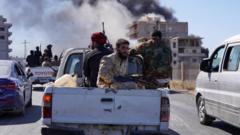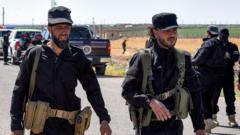In an alarming escalation of violence, over 100 people have died in southern Syria's Sweida Province due to recent clashes between the Bedouin tribes and Druse militias, revealing the ongoing instability of the area and the ineffectiveness of the Assad-led government.
# Renewed Violence in Southern Syria: A Prevention of Peace?

# Renewed Violence in Southern Syria: A Prevention of Peace?
An outbreak of violent sectarian clashes showcases the Syrian government's struggle for control amid regional tensions.
More than 100 fatalities have been reported in southern Syria over the past few days amid violent confrontations in the Sweida Province, highlighting one of the region's most severe waves of sectarian violence in years. The conflict, which erupted after a Bedouin tribe reportedly assaulted a Druse individual, has spiraled into a larger confrontation as government forces and Israeli military involvement complicate the situation further.
The initial clashes started when members of a Bedouin tribe allegedly attacked and robbed a Druse man along Sweida's main highway, prompting retaliatory actions that escalated into fierce exchanges of gunfire and abductions between the two groups. According to the Syrian Observatory for Human Rights, the violence has resulted in a significant death toll since it began on Sunday.
As tensions mounted, Syrian government forces were deployed to restore order, but their presence was met with suspicion by Druse militia, who suspected the government might be aligning with the Bedouins against them. This mistrust led to confrontations between the Druse militia and government troops.
The Israeli military further intervened by launching airstrikes on Syrian government forces in the Sweida region, exacerbating the unrest. On Tuesday, in an effort to de-escalate the situation, the Syrian minister of defense called for a ceasefire and deployed additional military reinforcements to the province.
The ongoing unrest not only underscores the fragility of the Assad government’s authority but also highlights the deep-seated divisions among various groups within Syria. The situation in Sweida has thrown the region into further chaos, marking a worrying trend in a country still grappling with the aftermath of a devastating civil war.
The initial clashes started when members of a Bedouin tribe allegedly attacked and robbed a Druse man along Sweida's main highway, prompting retaliatory actions that escalated into fierce exchanges of gunfire and abductions between the two groups. According to the Syrian Observatory for Human Rights, the violence has resulted in a significant death toll since it began on Sunday.
As tensions mounted, Syrian government forces were deployed to restore order, but their presence was met with suspicion by Druse militia, who suspected the government might be aligning with the Bedouins against them. This mistrust led to confrontations between the Druse militia and government troops.
The Israeli military further intervened by launching airstrikes on Syrian government forces in the Sweida region, exacerbating the unrest. On Tuesday, in an effort to de-escalate the situation, the Syrian minister of defense called for a ceasefire and deployed additional military reinforcements to the province.
The ongoing unrest not only underscores the fragility of the Assad government’s authority but also highlights the deep-seated divisions among various groups within Syria. The situation in Sweida has thrown the region into further chaos, marking a worrying trend in a country still grappling with the aftermath of a devastating civil war.



















